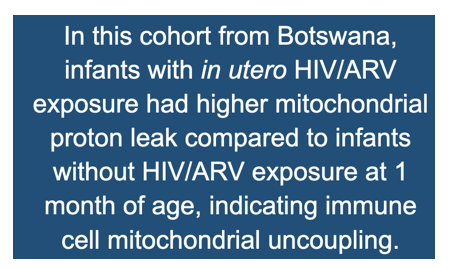| |
MITOCHONDRIAL PROTON LEAK IN INFANTS WITH IN
UTERO HIV AND ART EXPOSURE IN BOTSWANA
|
| |
| |
Download the PDF here
CROI 2022

Abstract Body
There are limited data on mitochondrial (mt) function in infants HIV-uninfected with in utero HIV and current antiretroviral therapy (ART) exposure (HEU).
Infants HEU and infants HIV-unexposed uninfected (HUU) were enrolled in the Tshilo Dikotla study in Botswana from 2016-2019. Mt basal and maximal respiration, ATP production, proton leak, spare respiratory capacity, and non-mt respiration were measured using a Seahorse XFe96 in viable peripheral blood mononuclear cells from infants at 1 month (mo) of age. Data on socio-demographics, maternal body mass index (BMI), gestational diabetes (GDM), HIV disease, and ART history, as well as infant preterm birth (<37 weeks gestation), breastfeeding, anthropometrics, and Homeostatic Model Assessment – Insulin Resistance (HOMA) were collected. Z scores for weight (WAZ) and length (LAZ) were calculated. Linear regression models were fit to assess the association between in utero HIV/ART exposure and each log-transformed mt function parameter, adjusting for confounders. Subgroup analyses were performed in infants HEU to assess the association of in utero ART [tenofovir (TDF)/emtricitabine (FTC)/dolutegravir (DTG) vs. TDF/FTC/efavirenz (EFV)] with each mt outcome.
Of 202 infants, 133 were HEU. Maternal age (29 vs. 26 yr, p<0.01) and parity (3 vs. 1, p<0.01) were higher among women of infants HEU vs HUU. Family history of DM, annual income, maternal BMI, GDM, tobacco/alcohol/substance use, preterm birth, and infant WAZ and LAZ were similar between groups. Among mothers of infants HEU, 47% had a CD4 count >500 cells/mm3 and 93% a viral load <40 copies/mL at enrollment, 68% received TDF/FTC/DTG, and 32% TDF/FTC/EFV. Median levels of mt proton leak were higher in infants HEU vs HUU [12.45 vs 10.78 pmol/min, p=0.02] in univariate analysis. (Table) This relationship persisted even after adjusting for maternal age, GDM, infant sex, preterm birth, WAZ, breastfeeding, and HOMA (mean difference in proton leak was 0.15 log units higher in HEU vs HUU, p<0.01). No differences in any other mt parameters were noted between groups. Among infants HEU, there was no association of in utero ART with any mt parameter.
In this cohort, infants HEU had higher mt proton leak compared to infants HUU at 1 mo of age, indicating immune cell mt uncoupling. While mt uncoupling may be a compensatory mechanism, it is also associated with increased oxidative stress which could potentially lead to metabolic diseases. Future studies are needed.
|
|
| |
| |
|
|
|